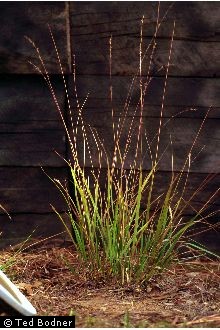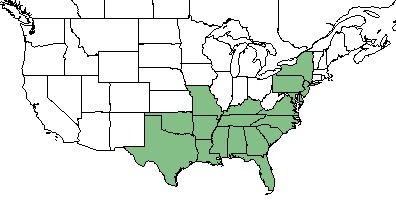Difference between revisions of "Chasmanthium laxum"
Krobertson (talk | contribs) |
|||
| Line 35: | Line 35: | ||
===Phenology=== <!--Timing off flowering, fruiting, seed dispersal, and environmental triggers. Cite PanFlora website if appropriate: http://www.gilnelson.com/PanFlora/ --> | ===Phenology=== <!--Timing off flowering, fruiting, seed dispersal, and environmental triggers. Cite PanFlora website if appropriate: http://www.gilnelson.com/PanFlora/ --> | ||
| − | ''C. laxum'' | + | ''C. laxum'' has been observed to flower in June and July. <ref name= "PanFlora"> Nelson, G. PanFlora: Plant data for the eastern United States with emphasis on the Southeastern Coastal Plains, Florida, and the Florida Panhandle. www.gilnelson.com/PanFlora/ Accessed: 18 MAY 2018 </ref> It is also shade-tolerant, enabling it to thrive under the canopy of other plants. <ref name= "Iglay 2010"> Iglay, R. B., et al. (2010). "Effect of plant community composition on plant response to fire and herbicide treatments." Forest Ecology and Management 260: 543-548. </ref> |
<!--===Seed dispersal===--> | <!--===Seed dispersal===--> | ||
<!--===Seed bank and germination===--> | <!--===Seed bank and germination===--> | ||
Revision as of 19:17, 12 September 2018
Common name: slender woodoats [1], slender spikegrass [2]
| Chasmanthium laxum | |
|---|---|

| |
| Photo from USDA NRCS Plants Database. | |
| Scientific classification | |
| Kingdom: | Plantae |
| Division: | Magnoliophyta - Flowering plants |
| Class: | Liliopsida - Moncots |
| Order: | Cyperales |
| Family: | Poaceae |
| Genus: | Chasmanthium |
| Species: | C. laxum |
| Binomial name | |
| Chasmanthium laxum (L) Yates | |

| |
| Natural range of Chasmanthium laxum from USDA NRCS Plants Database. | |
Contents
Taxonomic Notes
Synonyms: Uniola laxa (Linnaeus) Britton, Sterns, & Poggenburg; Chasmanthium laxum var. laxum
Varieties: none
Description
C. laxum is a perennial graminoid of the Poaceae family native to North America. [1]
Distribution
C. laxum can be found along the southeastern coast from Texas to New York. [1]
Ecology
Habitat
C. laxum can be found in savanna-pocosin ecotones, sandhill-pocosin ecotones, moist hardwood swamps, bottomland hardwood forests, mesic hammocks, and other moist habitats.[2][3] It also occurs in upland closed-canopy forests where fire is excluded, including slope forest and upland hardwood (beech-magnolia) forest.[3]
Phenology
C. laxum has been observed to flower in June and July. [4] It is also shade-tolerant, enabling it to thrive under the canopy of other plants. [5]
Fire ecology
C. laxum is not fire resistant and has no fire tolerance. [1]
Use by animals
C. laxum is highly palatable to browsing and grazing animals. [1]
Conservation and Management
C. laxum is listed as an endangered species by the New York Department of Environmental Conservation Division of Land and Forests, and the Pennsylvania Department of Conservation and Natural Resources. [1]
Cultivation and restoration
Photo Gallery
References and notes
- ↑ 1.0 1.1 1.2 1.3 1.4 1.5 USDA Plant Database https://plants.usda.gov/core/profile?symbol=CHLA6
- ↑ 2.0 2.1 Weakley, A. S. (2015). Flora of the Southern and Mid-Atlantic States. Chapel Hill, NC, University of North Carolina Herbarium.
- ↑ 3.0 3.1 Florida Natural Areas Inventory 2010. Guide to the natural communities of Florida: 2010 edition. Florida Natural Areas Inventory, Tallahassee, Florida, 228 pg.
- ↑ Nelson, G. PanFlora: Plant data for the eastern United States with emphasis on the Southeastern Coastal Plains, Florida, and the Florida Panhandle. www.gilnelson.com/PanFlora/ Accessed: 18 MAY 2018
- ↑ Iglay, R. B., et al. (2010). "Effect of plant community composition on plant response to fire and herbicide treatments." Forest Ecology and Management 260: 543-548.